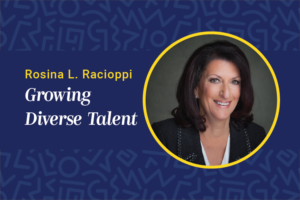
How scaffolding and sequencing present new opportunities.
by Dr. Rosina L. Racioppi
January 20, 2023
The start of a new year is traditionally a time to look at what we hope to achieve in the months ahead and what we need to do differently to turn those hopes into reality. Certainly, advancing and retaining female talent is an area meriting that focus.
Retention of female talent will continue to be a challenge in 2023, propelled by any ongoing COVID-related disruptions, shifts in the labor market and lingering effects of the Great Resignation.
I’d like to suggest we reimagine our strategies for advancing and retaining female talent and focus on two areas which I call “scaffolding” and “sequencing.”
Scaffolding: Much more than a metaphor
In building and construction, scaffolding is the structure that allows the work to get done. It surrounds the edifice and enables progress to be made in all directions. When it comes to advancing and retaining female talent, we need to think of our initiatives as intertwined scaffolding that surrounds everything we do.
Scaffolding our initiatives to advance and retain female talent means we weave together talented women with the development programs we offer them, the managers who support and promote them and the mentors who help them achieve their goals.
For example, for almost 30 years, our work at WOMEN Unlimited of developing female talent has shown empirically that when the triad of women, managers and mentors are actively and intentionally intertwined the results are significant and measurable. The women themselves become more capable and competent, they become more engaged and committed to a long-term career in the organization, managers and mentors gain a greater understanding of the challenges current-day women face and corporate culture shifts to a more diverse and inclusive environment.
Additionally, scaffolding and its open-minded frame of mind invites us to objectively assess what we’ve done and what more we need to do. It makes us more willing to let go of our search for “the one right way” and instead stay on the lookout for better ways. Almost invariably, the result is more productive strategies, driven by diverse insights and divergent points of view.
Sequencing: A challenge to both women and CLOs
I’ve seen this happen many times. Organizations try to force fit women into growth and development initiatives. If they are not ready or if they are not primed for the opportunity, the effort can backfire, doing more harm than good and making women believe the organization doesn’t understand their situation or their goals.
Sequencing is an antidote. It lets organizations individualize learning and development approaches so that women become active participants in their career trajectory: When they advance, how they advance and to where they advance. It is a customized approach to growth and L&D in which strategies are enacted in an order mutually agreed upon by a woman and her manager. As a result, since women’s requirements and timing are taken into consideration, they better realize their value to the organization.
Sequencing is a two-way street. It allows organizations to craft strategies that will get enthusiastic buy-in from individuals in a diverse talent pool. And, it invites women to intentionally focus on their goals and how and when to take the steps to achieve those goals.
For example, one highly successful approach to sequencing for both women and their organizations is ensuring that “ the right woman is in the right program at the right time.”
While scaffolding and sequencing are independent strategies, they share a common denominator for success. Both require a partnership and a commonality of purpose across learning officers, managers, mentors and female talent. Through that interaction, women can advance, corporate cultures become more inclusive and companies successfully combat the loss of diverse talent. The results are further reinforced when scaffolding and sequencing work in tandem.
Happy 2023! It is my hope that as the year progresses, scaffolding and sequencing will gain a stronger foothold in advancing and retaining a more diverse talent pool.




